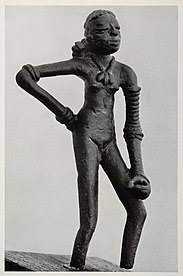
Mohenjodaro’s Dancing Girl
30.05.2023
Mohenjodaro’s Dancing Girl , Daily Current Affairs , RACE IAS : Best IAS coaching in Kanpur
Main Examination General Studies Question Paper 1
( Art & Culture )
In News:
- On International Museum Day, Prime Minister Narendra Modi inaugurated the International Museum Expo, an event that showcased various cultural exhibits and artefacts. One of the highlights of the event was the unveiling of a captivating mascot, the Dancing Girl, which attracted both praise and criticism for its adaptation from the original bronze statue discovered at Mohenjodaro.
- The traditional craft of Channapatna toys was used to make this mascot.
About Channapatna toys:
- Channapatna toys are a particular form of wooden toys and dolls that are manufactured in the town of Channapatna in the Ramanagara district of Karnataka.
- This traditional craft is protected as a Geographical Indication (GI).
- As a result of the popularity of these toys, Channapatna is known as the Gombegala Ooru (toy- town) of Karnataka.
- Traditionally, the work involved lacquering the wood of the Wrightia tinctoria tree, colloquially called Aale mara (ivory-wood).
Mohenjo-Daro:
- Mohenjo-Daro or the “Mound of the dead” lies in Larkana district of Sindh (Pakistan), about 5 km away from the Indus.
- It is one of the largest of the Indus Valley Civilization sites.
- It was discovered by archeologists Rakhaldas Banerji and Sir John Marshall.
- The site is famous for its elaborate town planning with street grids with brick pavements, developed water supply, drainage, and covered sewerage systems, homes with toilets, and monumental buildings.
- Its excavations revealed findings like the Great Bath, Great Granary, a large assembly hall, temple-like structure, the seal of Pashupati and a bust of a bearded man.
- It is the most glaring example of town planning in the Harappan civilization. The city is divided into citadel and lower city.
- The civilization went into decline in the middle of the second millennium BC for reasons that are believed to include catastrophic climate change.
About the Mohenjo Daro’s Dancing Girl:
- The Dancing Girl was discovered in 1926, by British archaeologist Ernest McKay in a ruined house in the ‘ninth lane’ of Mohenjodaro’s citadel.
- Even though Mohenjodaro and Harappa became part of Pakistani territory after the Partition, the Dancing Girl remained in India as part of an agreement.
- Today, the bronze figurine sits in the National Museum of India as an artifact, often referred to as its “star object”.

Why is it called Dancing Girl?
- Over the years, the Dancing Girl has been an object of fascination for archaeologists and historians. Of particular interest has been the pose the woman strikes and what that means.
- John Marshall, Director-General of the ASI from 1902 to 1928 who oversaw the initial excavations in Harappa and Mohenjodaro, described the figurine as “a young girl, her hand on her hip in a half-impudent posture, and legs slightly forward as she beats time to the music with her legs and feet”.
- As Marshall’s description suggests, it is the pose that the figurine strikes that has led historians to believe that the woman depicted was a dancer. However, there is no other evidence to support this claim.
- Recent work on the issue has suggested that the “dancer” label came from readings of Indian history from later dates, when court and temple dancers were commonplace.
Significance:
- The Dancing Girl is evidence of the civilisation’s knowledge of metal blending and lost-wax casting – a complicated process by which a duplicate sculpture is cast from an original sculpture to create highly detailed metallic artefacts.
- Moreover, the very existence of a figurine such as the Dancing Girl, indicates the presence of high art in Harappan society.
- While art has probably been around since the very beginning of human existence, the degree of its sophistication indicates a society’s advancement.
- The Dancing Girl by all appearances is not an object built for some utilitarian purpose – artists took great time to create an artefact of purely symbolic, aesthetic value.
- Beyond the debate surrounding the Dancing Girl’s identity, the figurine serves as a testament to the sophistication of Harappan artistry and metallurgy. Its existence showcases the advanced knowledge of metal blending and the intricate lost-wax casting technique employed by the ancient civilization. The presence of such a symbolic and aesthetically crafted artifact suggests the existence of high art and cultural refinement within Harappan society.
Source: INDIAN EXPRESS
----------------------------------------
|
Mains Exam Question Underline the importance of the dancing girl in the context of Indian art and culture, which has become a topic of discussion recently. |